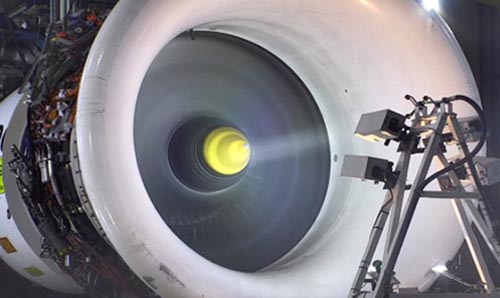Atmospheric dust and jet engines: better test regimes for improved business performance
In collaboration with Rolls-Royce, Dr Nick Bojdo and colleagues in the cross-Department research group “Dust”, have developed new types of ‘test dust’ to improve our understanding of a jet engine's lifespan when operating to and from arid regions of the world.

Dust is a key concern for aircraft operators flying in arid regions (such as the Middle East and Central Asia). Dust ingestion impacts upon the lifespan and efficiency of engines and with climate change increasing the amounts of dust in the atmosphere due to droughts, extreme weather events and vegetation loss, engine manufacturers find their products operating in increasingly challenging conditions.
But, not only are companies, such as Rolls Royce, faced with an engineering problem, they are also faced with a business problem. More and more airlines are choosing to lease engines directly from manufacturers, therefore shifting technical and financial responsibility from themselves back to the manufacturer. This makes it necessary for manufacturers to accurately model an engine's performance under conditions close to those that they will be flying in, especially when operators are more relaxed about flying in poor atmospheric conditions as they know they are not responsible for the performance of the engine.
A team of our researchers, led by Dr Nick Bojdo, have developed new types of "test dust" to simulate the flying conditions engines are exposed to. The collaborative project between academics in the Aerodynamics research group in the Department of Mechanical, Aerospace and Civil Engineering (MACE) and Department of Earth and Environmental Sciences (EES) look at the precise chemical interaction between jet engines and the components of the sand and dust.
We use jet engineering and geological science to run experiments that recreate arid flying conditions and allow us to investigate the factors that control the processes that lead to damage. By analysing this, we can predict the cost of operating jet engines in these kinds of environments.
Dr Nicholas Bojdo / Lecturer in Aerospace Engineering
How dust changes in extreme conditions
Jet engines produce thrust by burning fuel in highly compressed air, and using the increase in thermal energy to turn a thrust-producing fan. When a grain of sand is sucked into an engine, the experience is like getting put into a blender and then an oven in a fraction of a second. It is unsurprising that some of the grains of sand and dust do not make it through the engine in one piece. Our researchers study this interaction between the sand that is sucked into the engine and the rotating machinery, and how this combination of events causes the life-limiting damage to jet engines.
How dust causes damage
All sand and dust is capable of eroding compressor blades and reducing their efficiency over time, but it's in the hot part of the engine that the chemistry really becomes important. At temperatures of up to 1450C, certain minerals melt and resolidify as they cool, accumulating as deposits that can clog fuel nozzles, block cooling passages, damage protective coatings and corrode metal surfaces in the engine.
To test the durability of air-aspirated engines and other mechanical components, manufacturers subject their equipment to sand exposure tests using a standardised blend of mineral powders, known as a test dust. The earliest test dusts were based on the chemical composition of the sediment found in the deserts of Arizona, where the testing would take place. Reflecting this, the composition of the subsequent internationally-agreed test dusts contain high proportions of minerals like quartz, which does indeed damages engines. However, due to local variations in the makeup of dust at airports around the world, the damage may manifest in different ways. As operations in and out of these locations have increased, it has become more important to ensure that the test dust more accurately replicates the type of damage that the engine experiences.
Addressing the issue
To address this, Dr Bojdo and the Dust Research Group are engaged in testing with Rolls-Royce, running a controlled RR Trent 900 engine and varying concentrations of different test dusts, including "Test Dust 50" - a mix high of evaporates such as calcite and dolomite. While these specific results are still under embargo, they showed significant deposition of minerals on turbine blades, preferential deposition of certain minerals and also new minerals being forged in the heat of the combustor and high-pressure turbine.
Subsequent tests within our Department on our AMT Olympus mini turbojet showed similar deposits on compressor blades, with a resulting loss of compressor performance and an increase in fuel consumption per unit of thrust. We are planning further tests to refine these findings and compare with the Rolls-Royce full engine test.
If you would like to find out more about the work Dr Bojdo and his team are doing, or are interested in business or research collaborations, please email:
